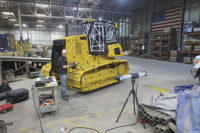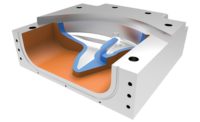Software & Analysis
Reverse Engineering: Backing into Quality
The ability to reverse engineer is quickly becoming a standard go-to practice in manufacturing.

A quality engineer scans a cast using a portable CMM equipped with a scanner head and a reverse engineering software application. Source: TCI Precision Metals, Los Angeles, CA

Using software and a laser scanner the original rotor blade was scanned to capture point cloud data of the actual parts. Source: Verisurf

The software creates a triangular mesh surface from the point cloud data. Source: Verisurf

Once mesh is acceptable, a CAD surface is constructed for design. The CAD tools creates NURB surface model from mesh surface. Source: Verisurf

Analysis of scan compared to reverse mesh. This software verifies reverse engineered CAD surface model to original point cloud scan data. Source: Verisurf

CAD model. The original CAD data was imported to software for analysis. Source: Verisurf

Measurements scanned and best fit to CAD model. Using reverse engineering software, the CAD surface was scanned to create a point cloud model of the contoured surface. Source: Verisurf

Mesh constructed from scanned data. The software converted the point cloud data in a surface mesh model. Source: Verisurf

Surface constructed from mesh for NC machine to be programmed to. Once verified, this software was again used to create a new CAD surface model from the mesh surface model. The new surface model is used for intelligent CNC programming. Source: Verisurf

CNC machine can cut 100% of the time with new CAD surface data. With the new surface, the CNC machine tool path can now be programmed to cut material 100% of the time, eliminating days and weeks of cutting, 24/7. Source: Verisurf












Once you've finished reading, be sure to watch the video "How Much Do You Know About Reverse Engineering" below!
Today’s quality, design and manufacturing engineers often require two gears to get their jobs done: forward and reverse. Yes, sometimes you need to back up in order to move forward.
New build manufacturing is all about moving forward. High performance CAD/CAM software and ever increasing processing power allow for virtually every aspect of design, manufacturing and testing be anticipated and confirmed in the digital space before a single component is produced. It all looks good on paper, so to speak, but the best-laid plans often go astray.
For example, what if
- a large mold tool for a composite aircraft wing has a high spot and the CNC tool path requires cutting air for days or even weeks while it works to get down to a uniform surface level?
- a single helicopter rotor blade needs replacement, but the blade no longer matches the new build spec due to the stresses of flight?
- cast parts require machining? The CAD model may be spot on, but no two castings are ever the same. How do you efficiently place the part on the CNC table and avoid tool crashes, while keeping the tool on the part cutting metal more of the time?
- a complex surface profile needs to be re-created or inspected with little or no CAD data?
Nearly all modern manufacturing processes start with a 3-D CAD model, so how do you start if you do not have a 3-D model?
TECH TIPS
|
The ability to reverse engineer, whether anticipated in the original build process or the result of a work-around to solve a problem, is quickly becoming a standard “go-to” practice in manufacturing and MRO environments. Reverse engineering software applications used in combination with capture devices, such as CMMs, portable CMMs, laser scanners, trackers and more provide engineers with a creative tool set to solve problems and increase productivity.
Reverse engineering software allows you to re-engineer CAD surfaces and other dimensions working with measured data from any digital capture device. The input is received as point clouds data, which can be a few measured points captured by a single probe, or millions of points captured by a scanning device. Once the data is captured, reverse engineering software translates the information from point cloud data to a mesh model, then to a surface model and finally, a precise 3-D CAD model.
Reverse engineering, assembly guidance and quality inspection are closely aligned as they all rely on accurate point data capture. When employing reverse engineering processes in manufacturing it is critical have accurate measurements and validate the outcome with a quality inspection routine tied to the newly reverse engineered model.
Reverse Engineering ‘As Cast’ Parts
When TCI Precision Metals receives a batch of cast parts for finished machining, a sample group of the parts are painted (a term used for scanning because it is similar to painting the part with a wide brush) using the CMM with scan head. The data is captured as a point cloud by reverse engineering software where it is then converted to a precise CAD model. The original CAD model is then overlaid with the ‘as cast’ CAD model and the two are digitally compared. This provides reference for exact placement of the part on the CNC table and allows the machine tool path to be optimized to cut metal more of the time while avoiding tool crashes. The tool path can also be modified to start cutting specific high points vs. cutting air over the entire part.
Reverse Engineering Complex Surface Profiles
Today’s parts often come with increasingly complex profiles, requiring a high degree of accuracy to ensure form, fit and function. Until recently, dimensioning and inspecting organic or free-formed profiles was a daunting task. These types of shapes are difficult to dimension and quite often they are a product of the “artist’s vision” and not always geometrically grounded, or they are a highly engineered functional shape that has been painstakingly optimized.
The key to successful inspection of a complex profile is a 3-D CAD which can come directly from your customer or design team, or can be reverse engineered from a physical part, or a prototype. Using metrology software and a portable CMM, either method works great and can accurately inspect surface profiles of plastic molded parts or tooling.
The value of reverse engineering in today’s manufacturing environment has increased dramatically. Improved processing speeds, advancements in data capture and ever-increasing software capabilities are delivering design, manufacturing and quality engineers the tools they need to develop creative solutions to manufacturing opportunities.
Reverse Engineering Large-Scale Bond ToolBy reverse engineering a large scale bond tool AIT was able to save days, even weeks of machining time. Fuselage and wing skins are large complex surfaces with extreme tolerances. Typically, creating a face sheet that starts out at one-inch thickness and is taken down to 0.5-inch will be reduced by less than 0.100 inch with each pass. The machine starts with the high points and works down. AIT use to “cut air” for days until the machine finally got down to the uniform layers. By creating a reverse engineered model and overlaying the original CAD model they were able to optimize the CNC tool path and cut material 100% of the time. This literally saves days and sometimes weeks of cutting, 24/7. Reverse Engineered Helicopter Rotor BladesAIT needed to design and build a bond tool for installation of the skin on rotor blade rebuilds. The challenge was after use, the rotor blade envelope changed, compared to when it was originally built. AIT used reverse engineering to capture the dimensions and contour of the envelope and provide data so they could design and build an accurate assembly tool. Once designed, they used inspection software to check accuracy during the build process, and for final QC before shipping. |
Looking for a reprint of this article?
From high-res PDFs to custom plaques, order your copy today!

















